Thyme
| Thyme | ||||||||||||
|---|---|---|---|---|---|---|---|---|---|---|---|---|

Common thyme ( Thymus vulgaris ) |
||||||||||||
| Systematics | ||||||||||||
|
||||||||||||
| Scientific name | ||||||||||||
| Thymus | ||||||||||||
| L. |
The thyme ( thymus , from ancient Greek θύμος thýmos ) or Quendel are a genus of plants within the family of the mint family (Lamiaceae). Some species and their varieties are medicinal and aromatic plants , the best known is the real thyme ( Thymus vulgaris ). The sand thyme ( Thymus serpyllum ), the lemon thyme ( Thymus × citriodorus ) and the broad-leaved thyme ( Thymus pulegioides ) are important in western culture and herbal medicine. The closely related heady thyme ( Thymbra capitata ) does not belong to the genus Thymus .
description


Vegetative characteristics
Thyme species are perennial half bushes or shrubs . Occasionally they appear to be herbaceous, but at least at the base they are woody. They grow upright to prostrate, are occasionally lawn-forming and rooting on the stems . The stems can be hairy all around or only have hair on two opposite sides or on the edges.
The leaves are simple and entire or occasionally serrated. Often the edges are bent over. The hairiness of the leaves is very variable within the genus, they can be completely hairless to completely hairy.
Inflorescences and flowers
The inflorescences are composed like a spike and pulled apart like a whorl or can be head-shaped . They contain bracts that are either similar in shape to the leaves or can be designed very differently. The flowers can be stalked or sessile, usually they are accompanied by small bracts that are at the base of the pedicel .
The hermaphrodite flowers are zygomorphic and five-fold with a double flower envelope . The calyx is more or less bell-shaped or cylindrical, usually traversed by ten veins and clearly two-lipped, with both lips sometimes being almost identical. The upper lip is set with three triangular teeth, but they are sometimes reduced to a single tooth. The two long triangular teeth of the lower lip can be curved upwards or splayed out. The throat is bearded and hairy. The crown is more or less tubular and divided into two lips, which can sometimes be almost identical. The corolla tube is sometimes very long and can then be up to 20 mm long. The coronet is divided into four lobes. The color of the crown can be white, cream, pink or purple, often there are translucent points in the crown throat or at the base of the crown lobes. The upper lip is more or less rounded, curved and straight. The lower lip and the lateral lobes are rectangular to almost circular, rounded and are perpendicular to the corolla tube.
The four stamens start in the upper half of the corolla tube and can be above it. The dust bags consist of two parallel bars . The plants can be gyno , then the stamens are receding or not pronounced. The tip of the stylus is branched.
Fruits and seeds
The fruits are egg-shaped nuts that contain round seeds .
Locations
Different species and their varieties are grown in gardens and horticultural companies. The thyme prefer light and dry locations with nutrient-poor and sandy soils and can be found on roadsides, on dry meadows and on walls.
use
In ancient Greece , thyme was used as an additive to incense, with which one achieved a stimulation of the mind and spirit. In the Middle Ages, thyme was already used as a valuable medicinal plant, for example for asthma or shortness of breath .
Today thyme is used in different ways. Species of the genus Thymus are used as dried or fresh culinary herbs , as a source of essential oils and oleoresins , as a garden plant and as a medicinal plant in folk medicine , homeopathy and increasingly also in classical medicine. However, only a small part of the species is of commercial importance, namely thymus mastichina , the sand thyme ( Thymus serpyllum ), the real thyme ( Thymus vulgaris ) and the yoke thyme ( Thymus zygis ), in addition to the one used here Systematic heady thyme ( Thymbra capitata ) that no longer belongs to the genus .
According to the European Pharmacopoeia, only the two types Thymus vulgaris and Thymus zygis or a mixture of both types are permitted for the production of the pharmaceutical drug thyme (Thymi herba) . Thymus serpyllum is the parent plant of the drug whalefish .
Ingredients and effects
The essential oil (1.0–2.5%) determines the effectiveness of the real thyme . This mainly consists of the monoterpenes thymol (25–50%) and carvacrol (3–10%) as well as p-cymene, borneol and linalool . The essential oil has a secretolytic , secretomotor and bronchospasmolytic effect. In addition, there is an anti-inflammatory effect due to thymol and carvacrol by inhibiting cyclooxygenase .
Systematics and distribution
The genus Thymus was established by Carl von Linné . Synonyms for Thymus L. are: Cephalotos Adans. , Mastichina Mill. , Serpyllum Mill.
The genus Thymus belongs to the subtribe Menthinae from the tribe Mentheae in the subfamily Nepetoideae within the family Lamiaceae .
The distribution areas are in Africa, Europe and temperate Asia. The center of biodiversity is the Mediterranean.
Sections and species with their distribution
The genus Thymus is divided into eight sections, some of which are divided into subsections and contain a total of 214 to 245 species:
Section Micantes (Velen.) Menitsky :
- Iridescent thyme or Azores thyme ( Thymus caespititius bread. )
- Thymus saturejoides Coss. : It occurs in three subspecies in Algeria and Morocco .
- Thymus riatarum Humbert & Maire : It occurs in northern Morocco.

Mastichina Section (Mill.) Benth. :
- Thymus mastichina (L.) L.
- Thymus albicans Hoffmanns. & Link : It occurs only from southern Portugal to southwestern Spain .
Section Piperella :
Section Teucrioides Jalas :
- Thymus teucrioides Boiss. & Spruner
-
Thymus hartvigii R.Morales : It comes in two subspecies in Greece before:
- Thymus hartvigii subsp. hartvigii : It occurs in south-central and southern Greece.
- Thymus hartvigii subsp. macrocalyx (Hartvig) R.Morales : It occurs from south-central Greece to the western Aegean islands.
- Thymus leucospermus Hartvig : It occurs in Greece.
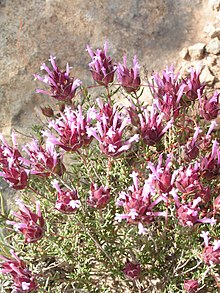
Section of Pseudothymbra Benth. :
- Subsection Pseudothymbra (Benth.) R.Morales :
- Thymus lotocephalus G.López & R.Morales : This endemic occurs only in southern Portugal.
-
Shaggy thyme ( Thymus villosus L. ): It occurs in three subspecies in Portugal and Spain:
- Thymus villosus subsp. lusitanicus (Boiss.) Cout. : It occurs in western Portugal and in south-central Spain.
- Thymus villosus subsp. velascoi R.Morales & G.López : It occurs in central Spain around Toledo.
- Thymus villosus subsp. villosus : It occurs in western and southwestern Portugal.
- Thymus longiflorus Boiss.
- Thin-skinned thyme ( Thymus membranaceus Boiss. ): This endemic occurs only in south-eastern Spain.
- Thymus moroderi Pau ex Martínez : This endemic occurs only in southeastern Spain.
-
Thymus munbyanus Boiss. & Reut. : It occurs in four subspecies in Morocco and Algeria:
- Thymus munbyanus subsp. abylaeus (Font Quer & Maire) Greuter & Burdet : It occurs in Morocco.
- Thymus munbyanus subsp. ciliatus (Desf.) Greuter & Burdet : It occurs in Algeria and Morocco.
- Thymus munbyanus subsp. coloratus (Boiss. & Reut.) Greuter & Burdet : It occurs in Algeria and Morocco.
- Thymus munbyanus subsp. munbyanus : It occurs from northern Morocco to northwestern Algeria.
- Thymus bleicherianus pomel : It occurs in Morocco.
-
Thymus funkii Coss. : It occurs in three subspecies, all three of which are only found in southeastern Spain:
- Thymus funkii subsp. burilloi Sánchez-Gómez
- Thymus funkii subsp. funkii
- Thymus funkii subsp. sabulicola (Coss.) Sánchez-Gómez
- Subsection Anomali (Rouy) R.Morales :
- Thymus antoninae Rouy & Coincy : It occurs in southeastern Spain.


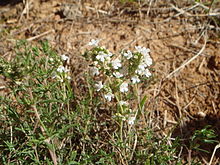
Thymus section :
- Thymastra subsection :
- Thymus capitellatus Hoffmanns. & Link
- Thymus camphoratus Hoffmanns. & Link
- Thymus subsection :
- Thymus carnosus Boiss.
- Real thyme ( Thymus vulgaris L. )
- Thymus orospedanus Villar : It occurs only in southern and southeastern Spain.
-
Thymus hyemalis Lange : It occurs in two subspecies only in southeastern Spain:
- Thymus hyemalis subsp. hyemalis
- Thymus hyemalis subsp. millefloris (D. Rivera, Flores & Laencina) R. Morales
- Yoke thyme or Spanish thyme ( Thymus zygis L. )
- Thymus baeticus Boiss. ex Lacaita : It occurs only in southern and southeastern Spain.
- Thymus willdenowii Boiss. : It occurs in Morocco, Algeria, Gibraltar and southwestern Spain.
- Thymus loscosii Willk. : This endemic occurs only in northeastern Spain.
- Thymus serpylloides Bory

Section Hyphodromi (A. Kern.) Halácsy :
- Subsection Subbracteati (Klokov) Jalas :
- Thymus algeriensis Boiss. & Reut. : It occurs in Morocco, Algeria, Tunisia and Libya .
- Thymus argaeus (Fish. & CAMey.) Boiss. & Balansa : This endemic occurs only in central Turkey.
- Thymus atticus Čelak.
- Thymus boissieri Halácsy : It occurs on the Balkan Peninsula .
- Thymus borysthenicus Klokov & Des.-Shost. : It occurs in Ukraine .
- Thymus brachychilus Jalas : It occurs in central and southern Turkey.
- Thymus cappadocicus Boiss. : It occurs in central and eastern Turkey.
- Cushion thyme ( Thymus cherlerioides Vis. )
- Thymus comptus Friv.
- Thymus convolutus Klokov : This endemic occurs only in eastern Turkey.
- Thymus dolopicus Formánek
- Thymus integer Griseb. : This endemic occurs only in Cyprus .
-
Thymus leucotrichus Halácsy : It occurs in two subspecies and one variety on the Balkan Peninsula, in Bulgaria , in the Eastern Mediterranean and on Crete :
- Thymus leucotrichus var. Creticus (Bald.) Ronniger : It occurs in Crete.
- Thymus leucotrichus subsp. leucotrichus : It occurs in Greece, Crete, Albania, Turkey and in the area of Syria and Lebanon.
- Thymus leucotrichus subsp. neiceffii (Degen & Urum.) Jalas : It occurs in Albania, Bulgaria and Greece.
- Thymus mastigophorus Lacaita
- Thymus pallasianus Haw. ex Schult. & Schult. f.
- Thymus parnassicus Halácsy : It occurs from the Balkan Peninsula to eastern Turkey.
- Thymus persicus (Ronniger ex Rech. F.) Jalas : This endemic occurs only in northeastern Iran .
- Thymus plasonii Adamovic
- Thymus pulvinatus Čelak. : It occurs in western Turkey.
- Thymus revolutus Čelak. : It occurs in southern Turkey .
- Thymus spinulosus Ten.
- Thymus striatus Vahl
- Serpyllastrum subsection :
- Thymus aznavourii Velen.
- Thymus bracteatus Lange ex Cutanda
- Thymus bracteosus Vis. ex Benth.
- Thymus canoviridis Jalas : It occurs in eastern Turkey.
- Thymus daghestanicus Klokov & Des.-Shost. (Syn .: Thymus hadzhievii Grossh. , Thymus lipskyi Klokov & Des.-Shost. ): It occurs in the Caucasus region.
- Thymus eremita Klokov : It occurs in Kazakhstan .
- Thymus fontqueri (Jalas) Molero & Rovira : This endemic occurs only in northeastern Spain.
- Thymus granatensis Boiss.
- Thymus haussknechtii Velen. : It occurs in eastern Turkey.
- Thymus helendzhicus Klokov & Des.-Shost. : It occurs in western Transcaucasia .
- Thymus incertus Klokov : It occurs in Kazakhstan and Uzbekistan .
- Thymus karjaginii Grossh. : It occurs in the eastern Transcaucasia.
- Thymus kirgisorum Dubj.
- Thymus lacaitae Pau : It occurs in central and central-eastern Spain.
- Thymus ladjanuricus Kem.-Nath. : It occurs in western Transcaucasia.
- Thymus leptophyllus Lange
- Thymus majkopiensis Klokov & Des.-Shost. : It occurs in the northwestern Caucasus region.
- Thymus nerczensis Klokov : It occurs in southern Siberia and northern Mongolia .
- Thymus pectinatus fish. & CAMey. : It occurs in central Turkey.
- Thymus petraeus Serg. : It occurs from western Siberia to northwestern China.
- Thymus samius Ronniger & Rech.f. : It occurs on Samos .
- Thymus spathulifolius Hausskn. & Velen. : It occurs in eastern Turkey.
- Thymus zygioides Griseb.
- Subsection Thymbropsis Jalas ex R.Morales :
- Thymus bovei Benth. : It occurs from Egypt to Israel .
- Thymus broussonetii Boiss. : It occurs in Morocco.
- Thymus cariensis Hub.-Mor. & Jalas : It occurs in southwestern Turkey.
- Thymus cilicicus Boiss. & Balansa : It occurs in the Eastern Mediterranean.
- Thymus decussatus Benth. : It occurs from Israel to the Arabian Peninsula.
- Thymus Eigii (Zohary & PHDavis) Jalas : It occurs from southern Turkey to western Syria .
- Thymus holosericeus Čelak.
- Thymus laconicus Jalas
- Thymus lanceolatus Desf. : This endemic occurs only in northern Algeria.
- Thymus leucostomus Hausskn. & Velen. : It occurs in northern and central Turkey.
- Thymus maroccanus ball : It occurs in Morocco.
- Thymus numidicus Poir. : It occurs from north-eastern Algeria to Tunisia.
- Thymus pallescens de Noé (Syn .: Thymus latifolius de Noé ): It occurs from northern Algeria to Tunisia.
- Thymus sipyleus Boiss. (Syn .: Thymus squarrosus Fisch. & CAMey. ): It occurs from the islands of the eastern Aegean to Transcaucasia.
-
Thymus syriacus Boiss. : It occurs in two varieties from Syria to northern Iraq:
- Thymus syriacus var. Edentatus Jalas : It occurs in northern Iraq.
- Thymus syriacus var. Syriacus : It occurs from Syria to northern Iraq.
Section Serpyllum (Mill.) Benth. :
- Insulares Jalas subsection :
- Thymus bornmuelleri Velen. : This endemic occurs only in north-western Turkey.
- Thymus dreatensis Batt. : It occurs in Algeria.
- Thymus guyonii de Noé : It occurs in Algeria.
- Thymus origanoides Webb & Berthel. : This endemic occurs only in Lanzarote .
-
Island thyme ( Thymus richardii Pers. ): It occurs in four subspecies in eastern Spain, the Balearic Islands , Sicily and Bosnia :
- Thymus richardii subsp. ebusitanus (Font Quer) Jalas : It occurs in Ibiza .
- Thymus richardii subsp. nitidus (cast.) Jalas : It occurs on the island of Marettimo .
- Thymus richardii subsp. richardii : It occurs in Mallorca and in Bosnia.
- Thymus richardii subsp. vigoi Riera, Güemes & Rosselló : It occurs in eastern Spain.
- Thymus willkommii Ronniger
- Subsection Kotschyani (Klokov) Jalas :
- Thymus carmanicus Jalas : It occurs from northern Iraq to Iran.
- Thymus collinus M.Bieb. (Syn .: Thymus armeniacus Klokov & Des.-Shost. ): It occurs in the Caucasus region.
- Thymus daenensis Čelak. : It occurs from northern Iraq to Iran.
- Thymus desjatovae Ronniger : It occurs in Transcaucasia.
- Thymus eriocalyx (Ronniger) Jalas : It occurs from Iraq to Iran.
- Thymus fallax fish. & CAMey. : It occurs from Turkey to Iran.
- Thymus fedtschenkoi Ronniger (Syn .: Thymus ararati-minoris Klokov & Des.-Shost .; Thymus kjapazi Grossh. ): It occurs from eastern Turkey to Iran.
- Thymus guberlinensis Ilyin
- Thymus intercedens (Heinr.Braun) Rech. F.
- Thymus koeieanus Ronniger : This endemic occurs only in north-western Afghanistan .
- Thymus kotschyanus Boiss. & High. (Syn .: Thymus eriophorus Ronniger ): It occurs from southern and eastern Turkey to Iran.
- Thymus migricus Klokov & Des.-Shost. : It occurs from eastern Turkey to Iran.
- Thymus pubescens Boiss. & Kotschy ex Čelak. : It occurs from eastern Turkey to Iran.
- Thymus roseus Schipcz. : It occurs from southwestern Siberia to Kazakhstan.
-
Thymus schimperi Ronniger : It occurs in two subspecies from Eritrea to Ethiopia :
- Thymus schimperi subsp. hedbergianus Sebsebe : It occurs in eastern Ethiopia.
- Thymus schimperi subsp. schimperi : It occurs from Eritrea to Ethiopia.
- Thymus serrulatus Hochst. ex Benth. : It occurs from western Eritrea to Ethiopia.
- Thymus transcaspicus Klokov : It occurs from northeastern Iran to southern Turkmenistan .
- Thymus transcaucasicus Ronniger (Syn .: Thymus fominii Klokov & Des.-Shost. , Thymus ziaratinus Klokov & Des.-Shost. ): It occurs from northeastern Turkey to northern Iran.
- Thymus trautvetteri Klokov & Des.-Shost. : It occurs from south-eastern Transcaucasia to northern Iran.
- Subsection Pseudopiperella Jalas :
- Corsican thyme ( Thymus herba-barona Loisel. )
- Thymus nitens Lamotte
- Subsection Isolepides :
- Thymus bulgaricus (Domin & Podp.) Ronniger : It occurs on the northern Balkan peninsula.
- Thymus coriifolius Ronniger (Syn .: Thymus sosnowski Grossh. ): It occurs in Transcaucasia.
- Thymus elisabethae Klokov & Des.-Shost. : It occurs in the northwestern Caucasus region.
- Austrian thyme ( Thymus odoratissimus Mill. , Syn .: Thymus glabrescens Willd. )
- Thymus karamarianicus Klokov & Des.-Shost. : It occurs in the eastern Transcaucasia.
- Thymus lavrenkoanus Klokov : It occurs in southwestern Siberia.
- Thymus longedentatus (Degen & Urum.) Ronniger
- Thymus markhotensis Maleev : It occurs in the western Transcaucasia.
- Steppe thyme or Pannonian thyme ( Thymus pannonicus All .; But also as a subsp. Pannonicus (All.) Kerguélen subspecies to Thymus pulegioides )
- Thymus przewalskii (Kom.) Nakai (Syn .: Thymus chankoanus Klokov ; is also put as a variety var.przewalskii (Kom.) Ronniger to Thymus quinquecostatus Čelak .)
- Thymus sibthorpii Benth.
- Thymus tiflisiensis Klokov & Des.-Shost. (Syn .: Thymus klokovii (Ronniger) Des.-Shost. ): It occurs in the eastern Transcaucasia.
- Thymus turczaninovii Serg. : It occurs from southern Siberia to Inner Mongolia.
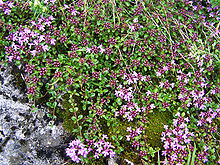

- Alternatives subsection :
- Thymus alpestris (Čelak.) Exchange ex A.Kern. : It occurs in the Eastern Alps and in the Carpathian Mountains .
- Thymus bihoriensis Jalas : It occurs in the eastern and southern Carpathians.
- Thymus comosus Heuff. ex Griseb. & Schenk
- Thymus disjunctus Klokov : It occurs from northeast China to Russia's Far East.
- Thymus komarovii Serg. (Syn .: Thymus semiglaber Klokov ): It occurs from Mongolia to Russia's Far East.
- Thymus nummularius M.Bieb. (Syn .: Thymus buschianus Klokov & Des.-Shost. , Thymus pseudonummularius Klokov & Des.-Shost .; Thymus pseudopulegioides Klokov & Des.-Shost. ): It occurs from Turkey to northern Iran.
- Thymus oehmianus Ronniger & Soska : This endemic occurs only in the north of North Macedonia .
- Thymus pulchellus C.A.Mey. : It occurs in the Caucasus region.
-
Broad-leaved thyme ( Thymus pulegioides L. ); with several subspecies including:
- Steppe thyme ( Thymus pulegioides subsp. Pannonicus (All.) Kerguélen , Syn .: thymus froelichianus Opiz )
- Thymus roegneri K. Koch (Syn .: Thymus alternans Klokov ): This endemic occurs only in southern Crimea .
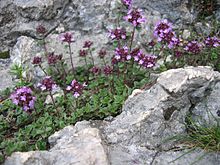

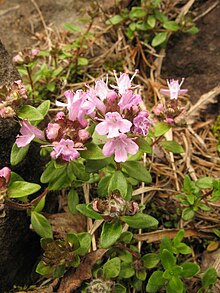
- Subsection Pseudomarginati (Heinr.Braun ex Borbás) Jalas :
- Thymus linearis Benth. : It occurs from northern Iran to the Himalayas and northwestern China.
- Dalmatian thyme or long stems and thyme ( Thymus longicaulis C.Presl ): It comes in two subspecies from southern Central Europe and Southeast Europe to Turkey before.
- Thymus nervosus J. Gay ex Willk. : It occurs from the Pyrenees to northern Spain and on Mont Ventoux in France.
- Thymus ocheus Heldr. & Sart. ex Boiss. (is also placed as a subsp. chaubardii (Rchb.f.) Jalas subspeciesto Thymus longicaulis )
-
Early flowering thyme or creeping thyme ( Thymus praecox Opiz ): There are about eight subspecies, including:
- Thymus praecox subsp. caucasicus (Willd. ex Ronniger) Jalas (Syn .: Thymus caucasicus Willd. ex Ronniger ): It occurs from southeastern Turkey to the Caucasus.
- Langhaariger thyme or alpine thyme ( Thymus praecox subsp. Polytrichus (A.Kern. Ex Borbás) Jalas )
- Thymus pulcherrimus Schur
- Thymus stojanovii sword
- Thracian thyme or long-tooth thyme ( Thymus thracicus Velen. )
- Subsection Serpyllum :
- Thymus alatauensis (Klokov & Des.-Shost.) Klokov : It occurs from southwestern Siberia to northeastern Kazakhstan .
- Thymus altaicus Klokov & Des.-Shost. : It occurs from the Altai to Mongolia.
- Thymus amurensis Klokov : It occurs from the Amur to northeastern China.
- Thymus arsenijevii Klokov : It occurs in Russia's Far East.
- Thymus brevipetiolatus Cap (Syn .: Thymus oxyodontus Klokov ): It occurs in eastern Siberia.
- Thymus crebrifolius Klokov : It occurs in Kazakhstan.
- Thymus crenulatus Klokov : It occurs in southern Siberia.
- Thymus curtus Klokov : It occurs from Russia's Far East to northeast China.
- Thymus diminutus Klokov : It occurs in Central Asia .
- Thymus diversifolius Klokov : It occurs in Russia's Far East.
- Thymus eravinensis Serg. : It occurs in southern Siberia.
- Thymus extremus Klokov : It occurs in northern Siberia.
- Thymus iljinii Klokov & Des.-Shost. : It occurs in Siberia.
- Thymus japonicus (H.Hara) Kitag. (Syn .: Thymus inaequalis Klokov , Thymus nervulosus Klokov ): It occurs from Siberia to Japan .
- Thymus manschuricus Ronniger : It occurs in northeastern China.
- Thymus minussinensis Serg. : It occurs from Siberia to Mongolia.
- Thymus mongolicus (Ronniger) Ronniger (Syn .: Thymus asiaticus Serg. , Thymus irtyschensis Klokov ): It occurs from Siberia to China.
- Thymus narymensis Serg. : It occurs in the Altai.
- Thymus ochotensis Klokov (Syn .: Thymus flexilis Klokov , Thymus glacialis Klokov ): It occurs from eastern Siberia to Russia's Far East.
- Thymus pavlovii Serg. (Syn .: Thymus bituminosus Klokov , Thymus eubaicalensis Klokov ): It occurs from Siberia to Mongolia.
- Thymus phyllopodus Klokov : It occurs in southern Siberia.
- Thymus proximus serg. : It occurs from the Altai to northwestern China.
- Thymus quinquecostatus Čelak. (incl. Thymus chankoanus Klokov and mostly also incl. Thymus przewalskii (Kom.) Nakai ): It occurs from Mongolia to Japan.
- Thymus reverdattoanus Serg. : It occurs from Siberia to Russia's Far East.
- Thymus shishkinii Serg. : It occurs in southern Siberia.
- Thymus seravshanicus Klokov (Syn .: Thymus aschurbajevii Klokov ; Thymus bucharicus Klokov , Thymus cuneatus Klokov ): It occurs in Central Asia.
- Sand thyme ( Thymus serpyllum L. , Syn .: Thymus laevigatus Vahl )
- Thymus sibiricus (Serg.) Klokov & Des.-Shost. (Syn .: Thymus jenisseensis Iljin ; Thymus tonsilis Klokov ): It occurs from Siberia to Mongolia.
- Thymus sokolovii Klokov : It occurs in Russia's Far East.
- Thymus talijevii Klokov & Des.-Shost. (Syn .: Thymus binervulatus Klokov & Des.-Shost. ): It occurs in two subspecies from European Russia to western Siberia.
- Thymus ussuriensis Klokov : It occurs in Russia's Far East and only in the Primorye region .
No longer belongs to the genus Thymus :
- Thymus punctatus Willd. → Ziziphora clinopodioides Lam.
Hybrids
There are numerous hybrids . Here is a selection:
- Lemon thyme ( Thymus × citriodorus (Pers.) Schreb. = Thymus pulegioides × Thymus vulgaris )
- Thymus × dimorphus Klokov & Des.-Shost. (= Thymus calcareus × thymus pulegioides subsp. Marschallianus )
- Thymus × oblongifolius exchange (Syn .: Thymus × podolicus Klokov & Des.-Shost. = Thymus pulegioides × Thymus serpyllum ).
- Thymus × Tschernjaievii Klokov & Des.-Shost. (Syn .: Thymus × czernjajevii Klokov & Des.-Shost. = Thymus pallasianus × Thymus pulegioides subsp. Pannonicus )
Botanical history
Before Linnaeus
Thyme is already mentioned in writings from the 1st century. For example, Pedanios Dioscurides spoke of a plant called thymo . According to a translation from the 16th century of the work of Dioscurides, however, a plant of the genus Satureja is meant. Also Pliny the Elder mentioned in his Naturalis Historia one white and one black shape of thyme.
Linnés generic concepts
Carl von Linné has largely adopted his knowledge of thyme from other authors, and the concept of the genus often changes in his publications. In 1737 he described six species in Hortus Cliffortianus , two of which are not included in the genus, but in Satureja or Acinos . In Hortus Upsaliensis from 1747 only two species are mentioned, namely Thymus vulgaris and Thymus mastichina . With the introduction of the binary nomenclature in the first edition of Species Plantarum , however, he again described eight species and today's Thymus mastichina as Satureja mastichina . In the second edition, this species is again assigned to the thyme, but Thymus pulegioides is no longer listed. Another species, Thymus piperella , was described by Linnaeus in 1767 in the 12th edition of the Systema Naturae .
According to Linnaeus
The first newly described species of the genus after Linnaeus is the thymus caespititius described by Felix de Avellar Brotero in 1804 . Other species from Portugal were described in 1809 by Johann Centurius von Hoffmannsegg and Johann Heinrich Friedrich Link . A first division of the genus into sections comes from George Bentham , who in 1834 divided the sections Mastichina , Serpyllum and Pseudothymbra .
Further initial descriptions come from the Swiss botanist Pierre Edmond Boissier , who mainly described species from the Iberian Peninsula , but also from northern Africa , Greece and Turkey and also set up the section Pseudothymbra . A division of the genus into the five sections Mastichina , Zygis , Piperella , Serpyllum and Pseudothymbra comes from Heinrich Moritz Willkomm and Johan Martin Christian Lange in 1868 . Further section concepts come from John Isaac Briquet , who edited the mint family in Adolf Engler's The Natural Plant Families and set up two sections, and from Josef Velenovský , who published a monograph of the genus in 1906 and recognized ten sections there.
Much of the more recent authors who have contributed to the study of the genus are from Spain. However, there are also a significant number of researchers studying the genus outside of Spain.
literature
- Elisabeth Stahl-Biskup, Francisco Sáez (ed.): Thyme: The Genus Thymus (= Medicinal and aromatic plants: industrial profiles. 24). Taylor & Francis, London, 2002, ISBN 0-415-28488-0 .
- Xi-wen Li, Ian C. Hedge: Thymus. In: Wu Zheng-yi, Peter H. Raven (Ed.): Flora of China . tape 17 : Verbenaceae through Solanaceae . Science Press / Missouri Botanical Garden Press, Beijing / St. Louis 1994, ISBN 0-915279-24-X , pp. 233 (English, online ). (Sections Description, Distribution and Systematics)
Individual evidence
- ↑ Eckehart J. Jäger, Friedrich Ebel, Peter Hanelt, Gerd K. Müller (eds.): Exkursionsflora von Deutschland . Founded by Werner Rothmaler. tape 5 : Herbaceous ornamental and useful plants . Springer, Spektrum Akademischer Verlag, Berlin / Heidelberg 2008, ISBN 978-3-8274-0918-8 .
- ↑ a b c d e f g h i j Ramón Morales: The history, botany and taxonomy of the genus Thymus. In: Elisabeth Stahl-Biskup, Francisco Sáez (ed.): Thyme: The Genus Thymus (= Medicinal and aromatic plants: industrial profiles. 24). Taylor & Francis, London, 2002, ISBN 0-415-28488-0 , pp. 1-43.
- ↑ Manfred Bocksch: The practical book of medicinal plants. blv, Munich 2007, ISBN 978-3-8354-0235-5 .
- ^ Brian M. Lawrence, Arthur O. Tucker: The genus Thymus as a source of commercial products. Elisabeth Stahl-Biskup, Francisco Sáez (ed.): Thyme: The Genus Thymus (= Medicinal and aromatic plants: industrial profiles. 24). Taylor & Francis, London, 2002, ISBN 0-415-28488-0 , pp. 252-262.
- ↑ Antonio Zarzuelo, Esperanza Crespo: The medical and non-medical use of thyme. In: Elisabeth Stahl-Biskup, Francisco Sáez (ed.): Thyme: The Genus Thymus (= Medicinal and aromatic plants: industrial profiles. 24). Taylor & Francis, London, 2002, ISBN 0-415-28488-0 , pp. 263-290.
- ↑ Rudolf Hänsel, Otto Sticher: Pharmakognosie - Phytopharmazie. 9th edition. Springer Medicine, Heidelberg 2009, ISBN 978-3-642-00962-4 , pp. 1023-1024.
- ↑ Siegfried Bäumler: Medicinal Plant Practice Today. Urban & Fischer, Munich 2007, ISBN 978-3-437-57271-5 , p. 412.
- ↑ a b c d e f g h i j k l m n o p q r s t u v w x y z aa ab ac ad ae af ag ah ai aj ak al am an ao ap aq ar as at au av aw ax ay az ba bb bc bd be bf bg bh bi bj bk bl bm bn bo bp bq br bs bt bu bv bw bx by bz ca cb cc cd ce cf cg ch ci cj ck cl cm cn co cp cq cr cs ct cu cv cw cx cy cz da db dc dd de df dg dh di dj dk dl dm dn do dp dq dr ds dt du dv dw dx dy dz ea eb ec ed ee ef eg eh ei ej ek el em en eo ep eq er es et eu ev ew ex ey ez Rafaël Govaerts (Ed.): Thymus. In: World Checklist of Selected Plant Families (WCSP) - The Board of Trustees of the Royal Botanic Gardens, Kew . Retrieved January 1, 2019.
- ^ Thymus in the Germplasm Resources Information Network (GRIN), USDA , ARS , National Genetic Resources Program. National Germplasm Resources Laboratory, Beltsville, Maryland. Retrieved January 13, 2018.

